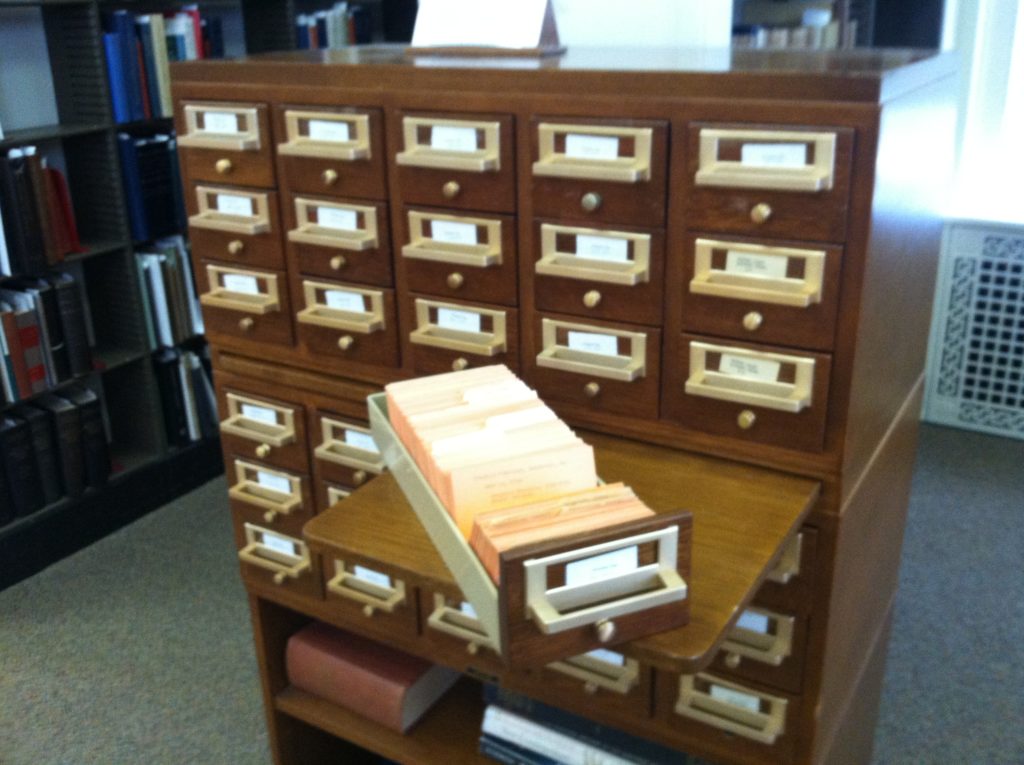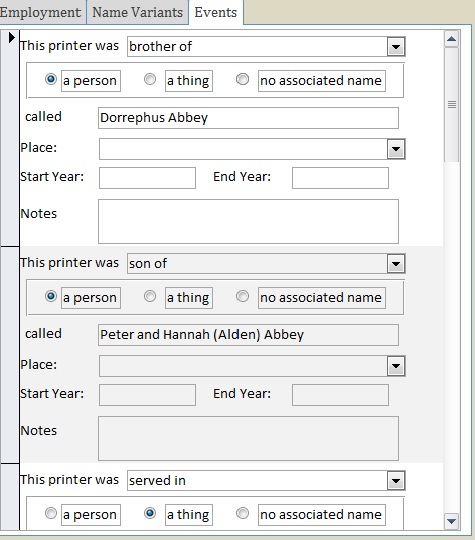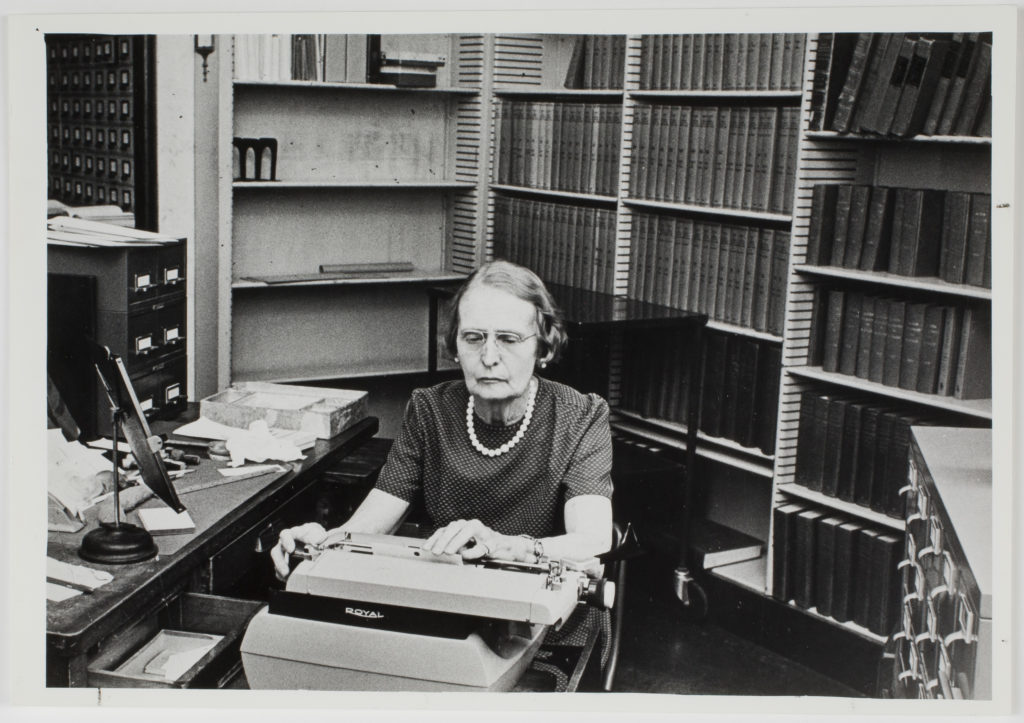 Emily Wells, who is working on the Printers’ File project at AAS this summer, received her B.A. from Mount Holyoke College in 2015. In the fall she will enter the History Ph.D. program at the College of William and Mary and begin work as an editorial apprentice at the Omohundro Institute of Early American History and Culture. Here she shares what she has learned while working with the Printers’ File.
Emily Wells, who is working on the Printers’ File project at AAS this summer, received her B.A. from Mount Holyoke College in 2015. In the fall she will enter the History Ph.D. program at the College of William and Mary and begin work as an editorial apprentice at the Omohundro Institute of Early American History and Culture. Here she shares what she has learned while working with the Printers’ File.
When you walk into the reading room, a number of objects might catch your eye, from the marble busts that flank the doorway to the portraits that stare down from the second floor balcony. One object that might escape your notice, however, is a brown wood cabinet that stands to the left of the main entrance. This cabinet, known as the Printers’ File, contains more than 16,000 typewritten cards that record the stories of approximately 6,000 people who were involved in the American book trade before 1820.
At present, this resource is only available to researchers who are able to visit the reading room and peruse the cards in person. To make the Printers’ File more easily accessible, AAS is working to digitize and transfer the information recorded on these cards to a linked open data resource. Not only will this resource make the Printers’ File available to anyone with a computer and internet access, but it will also allow researchers to answer complex research queries and draw connections between the people and places recorded within the scope of the project.
As the person hired to enter data, I am working to interpret and transfer the information written on the original typewritten cards to a digital environment while also helping to formulate guidelines that will standardize the data entry process. Through my work with the Printers’ File, I have discovered that there is a fundamental difficulty that arises when attempting to fit biographical information into a standardized format. To create a working dataset, one must determine the best way to field a person’s life experience, something that is inherently messy and complex, within the limits of a data entry form.

 Although there is no perfect solution to this problem, there are several ways that we can record the unique details of a person’s life while also maintaining consistency across the entire dataset. One way we can accomplish this is by entering information in a specially created “events” form. This form, which is separate from, but connected to the form that contains information regarding a person’s profession, allows us to record the more unusual aspects of a person’s life in a searchable format. For example, if someone was banished, held for ransom, impressed into the navy, or enslaved, we can create unique entries for those occurrences. By creating these events, we avoid relegating information to the notes, a catchall field that renders the data unsearchable and therefore, somewhat unusable.
Although there is no perfect solution to this problem, there are several ways that we can record the unique details of a person’s life while also maintaining consistency across the entire dataset. One way we can accomplish this is by entering information in a specially created “events” form. This form, which is separate from, but connected to the form that contains information regarding a person’s profession, allows us to record the more unusual aspects of a person’s life in a searchable format. For example, if someone was banished, held for ransom, impressed into the navy, or enslaved, we can create unique entries for those occurrences. By creating these events, we avoid relegating information to the notes, a catchall field that renders the data unsearchable and therefore, somewhat unusable.
Another challenge arises when attempting to interpret the cards themselves. Avis Clarke, the woman who created the Printers’ File, devised a system that allowed her to record information in a consistent manner, even when she returned to cards years later with new research. Starting in 1927, Clarke combed through a vast number of imprints, newspapers, and secondary sources to find information that could be incorporated into the Printers’ File. Before I could understand the essential data recorded on the cards, I first had to familiarize myself with Clarke’s method. Every so often, her quirks and idiosyncrasies shine through and create an extra challenge of decoding her research before entering it into the data entry form.

Although the Printers’ File contains records for a number of well-known individuals, some of the most colorful stories are those that are relatively unknown. For example, James Adams, the first printer in Wilmington, Delaware, was forced to move his press to Doylestown, Pennsylvania, in 1777 to escape the British forces. Another printer, Daniel Bowen, gave up his business in 1788 to travel the country exhibiting his collection of wax sculptures. The Printers’ File also contains the stories of a handful of women who participated in the early American book trade. One of these women, Mary Baldwin, took over her husband’s printing business in Kingston, Jamaica, after his death in 1722. A few decades earlier, Mary Avery began working as a bookseller in Boston after the death of her first husband in 1678 and continued her business even after she remarried in 1679.
Once the project is complete, these stories and many others will be available to researchers anywhere in the world. With a single search, we will be able to comb through thousands of records. For example, we could compile a complete list of women who owned printing offices in early America or search through the names of printers who learned their trade in Europe before immigrating to North America. Regardless of specialty, scholars of early American history will undoubtedly find something of interest.
This fall, as I begin my first year as a History PhD student at the College of William and Mary, I will have the chance to apply skills I learned while working on the Printers’ File to my own research. Not only has this experience opened my eyes to the varied world of the early American book trade, but it has also given me an inside look into how digital repositories of information are constructed, knowledge that will make it easier to find and navigate these resources in the future.
Support for this work has been generously provided by the Delmas Foundation, the Lapidus Digital Enterprise Fund, and the Pine Tree Foundation of New York.

2 thoughts on “Transforming the Printers’ File into a Linked Open Data Resource”